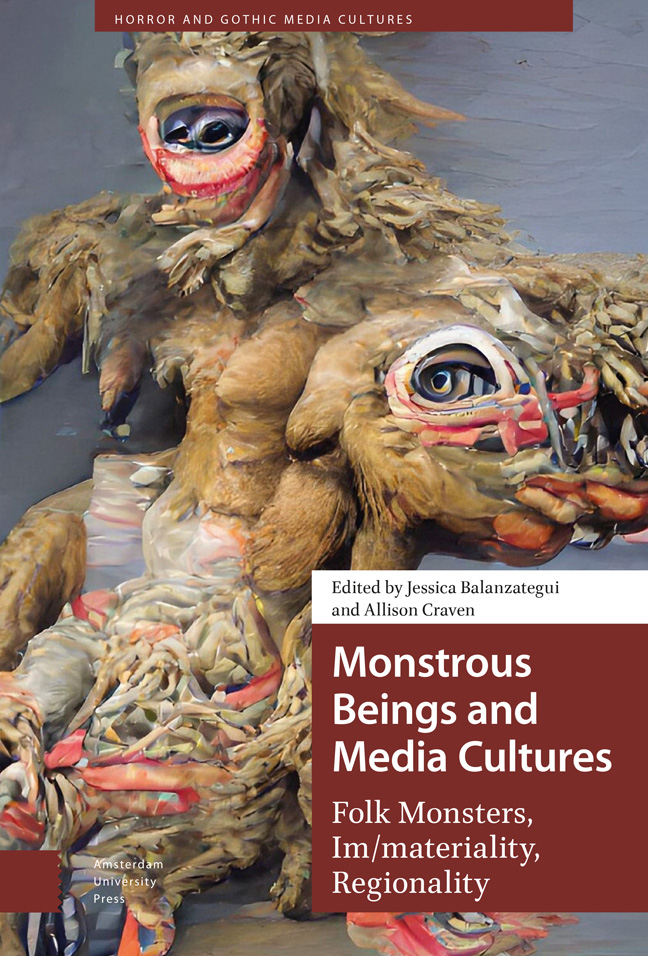Book contents
- Frontmatter
- Contents
- List of Figures
- Acknowledgements
- Introduction: Folk Monsters and Monstrous Media: The Im/materialties, Modalities, and Regionalities of Being(s) Monstrous
- 1 The Momo Challenge as Urban Legend: Child and Adult Digital Cultures and the Global Mediated Unconscious
- 2 “Every Imaginable Invention of the Devil”: Summoning the Monstrous in Eurocentric Conceptions of Voodoo
- 3 The Forest and the Trees: The “Woods” as Intersection between Documentary, Fairy Tale, and Internet Legend in Beware the Slenderman
- 4 Mark Duplass as Mumblegore Serial Killer: Fictional Vernacular Filmmaking in the Creep Series
- 5 Monsters in the Forest: “Little Red Riding Hood” Crimes and Ecologies of the Real and Fantastic
- 6 A Mother's Milk: Motherhood, Trauma, and Monstrous Children in Folk Horror
- 7 Documenting the Unheard: The Poetics of Listening and Empathy in The Family
- 8 Reimagining the Pontianak Myth in Malaysian Folk Horror: Flexible Tradition, Cinema, and Cultural Memory
- 9 An Uncommon Ancestor: Monstrous Emanations and Australian Tales of the Bunyip
- 10 The Folk Horror “Feeling”: Monstrous Modalities and the Critical Occult
- Works Cited
- Mediagraphy
- Index
1 - The Momo Challenge as Urban Legend: Child and Adult Digital Cultures and the Global Mediated Unconscious
Published online by Cambridge University Press: 17 February 2024
- Frontmatter
- Contents
- List of Figures
- Acknowledgements
- Introduction: Folk Monsters and Monstrous Media: The Im/materialties, Modalities, and Regionalities of Being(s) Monstrous
- 1 The Momo Challenge as Urban Legend: Child and Adult Digital Cultures and the Global Mediated Unconscious
- 2 “Every Imaginable Invention of the Devil”: Summoning the Monstrous in Eurocentric Conceptions of Voodoo
- 3 The Forest and the Trees: The “Woods” as Intersection between Documentary, Fairy Tale, and Internet Legend in Beware the Slenderman
- 4 Mark Duplass as Mumblegore Serial Killer: Fictional Vernacular Filmmaking in the Creep Series
- 5 Monsters in the Forest: “Little Red Riding Hood” Crimes and Ecologies of the Real and Fantastic
- 6 A Mother's Milk: Motherhood, Trauma, and Monstrous Children in Folk Horror
- 7 Documenting the Unheard: The Poetics of Listening and Empathy in The Family
- 8 Reimagining the Pontianak Myth in Malaysian Folk Horror: Flexible Tradition, Cinema, and Cultural Memory
- 9 An Uncommon Ancestor: Monstrous Emanations and Australian Tales of the Bunyip
- 10 The Folk Horror “Feeling”: Monstrous Modalities and the Critical Occult
- Works Cited
- Mediagraphy
- Index
Summary
Abstract
From late 2018 to early 2019, a mysterious character called “Momo” became the subject of an international news cycle about the dangers of children's internet use. This news reportage and social media commentary circulated around the now infamous image of “Momo”: a close-up photograph of an inhuman but woman-like face with stringy black hair, bulging, lid-less eyes, a pig-like nose, and a wide, angular smile. The global discourse about Momo resulted in an urban legend that operated in dual registers: one across adult-oriented news and social media, and another amongst children's and youth participatory digital cultures. This chapter's analysis of the development of a dual-layered urban legend about the character illuminates how Momo continues longstanding cultural anxieties about telepresence and electronic mediation into the participatory digital age.
Keywords: Momo, urban legend, children's digital cultures, YouTube, global mediated unconscious
Towards the end of 2018 and in the first few months of 2019, a mysterious character called “Momo” became the subject of an international news cycle about the dangers of children's internet use. Pervasive across this international reportage was the now infamous image of the Momo character: a close-up photograph of an inhuman but woman-like face with stringy black hair, bulging, lid-less eyes, a pig-like nose, and a wide, angular smile. The news stories detail a sinister “challenge” that targets children online, which is supposedly enacted by shadowy figures with unclear motives via social media who use the unsettling image as their profile picture to pretend to be “Momo.” As well as delivering a dangerous challenge to children via social media sites and apps – a challenge that compels children to complete increasingly risky tasks, with the final task reportedly being suicide – Momo's visage apparently appeared in children's content on YouTube. In one example oft cited in news reports, Momo's image accompanies a song that roughly follows the tune of the nursery rhyme “Ring Around the Rosy” (the tune of which is echoed in the children's teasing rhyme “Na na na na naaa naaa”). As the Momo image appears, a young child's voice can be heard singing:
Momo, Momo, Momo's gonna kill you.
- Type
- Chapter
- Information
- Monstrous Beings and Media CulturesFolk Monsters, Im/materiality, Regionality, pp. 33 - 62Publisher: Amsterdam University PressPrint publication year: 2023



